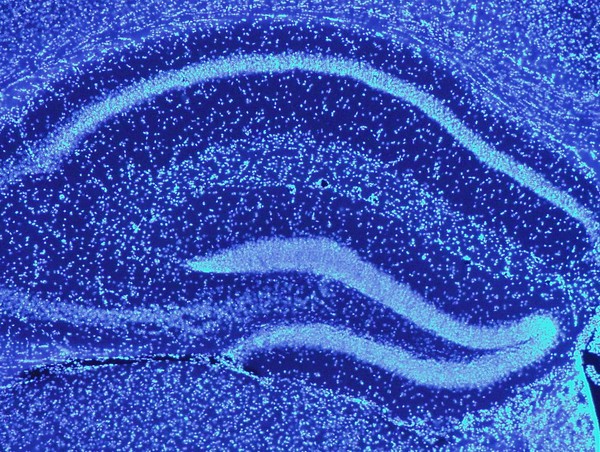

The hippocampal region, the focus of the current study, is a central part of the brain machinery involved in memory and also one of the first regions to be affected in cognitive decline conditions. The glowing dots are individual neurons. Source: DZNE/E. Benito-Garagorri
The scientists were also able to clarify how the substance acts upon the metabolism of nerve cells. A team led by Prof. André Fischer, who is a researcher at the German Center for Neurodegenerative Diseases (DZNE) and the University Medical Center Göttingen (UMG), reports these findings in the “Journal of Clinical Investigation”. The scientists now intend to test whether this or similar drugs may slow down the cognitive decline of people with dementia.
Alzheimer’s disease interferes with the organism’s normal functioning in many ways. One aspect that is increasingly becoming the focus of research is gene expression. This term is used to describe the phenomenon that only part of the DNA in a cell is active at any time.
“Some genes are switched on and others are switched off depending on the cell type and circumstance,” explains Fischer, site speaker for the DZNE in Göttingen and professor at the UMG. “In Alzheimer’s, this pattern of activity is dysregulated, particularly in the nerve cells inside the brain. This impairs learning skills and memory.”
Influencing gene activity
Certain gene expression regulators, called “histone deacetylase inhibitors”, have been under consideration for some time as a possible treatment for Alzheimer’s disease. Vorinostat – also known as SAHA and currently used to treat lymphoma – is one of the substances in this category.
“These drugs act upon helper proteins that are involved in gene expression. This can have a positive effect on medical conditions,” says Fischer. Such an impact was suggested by previous laboratory studies. However, as the researcher explains, until now there were not enough data to test these substances on patients.
Study of mice
“For this reason we made a detailed study. We looked how Vorinostat acts upon signs of aging, and also how it affects signs of disease. Our intention was to provide a basis for innovative clinical studies” says the neuroscientist.”
The researchers treated two groups of mice with learning and memory-related difficulties. In one group, the cognitive problems were age-related. The mice in the second group were younger, but harboured a genetic defect that leads to accumulation of protein aggregates such as those found in Alzheimer’s patients. These animals also showed distinct cognitive impairments.
“Vorinostat improved the learning and memory skills in both groups“, says Fischer. “We also found that it acts primarily on neurons. The drug alleviated brain inflammation and restored gene expression to an almost normal pattern.”
Furthermore, the study showed how Vorinostat promotes the ability of nerve cells to link up with each other. This ability is called “synaptic plasticity”. “Synaptic plasticity is essential for cognition”, Fischer explains. “Synaptic plasticity allows the brain to build connections among neurons and to rearrange them when needed. This is a prerequisite in order to process information efficiently.”
Next step: study with patients
“Ultimately, we were able to show what Vorinostat actually does – not only how it influences symptoms, but also what happens at the cellular level,” Fischer summarizes. “In the end, we now have enough data to test the effects on patients. This is a classic example of how fundamental research can pave the way for clinical studies.”
Based on these results, a DZNE clinical study involving patients in the early stages of Alzheimer’s disease is planned. This study is to begin very soon, and will also be supported by the “Alzheimer Stiftung Göttingen” of the University Medical Center Göttingen.
Original publication:
„Reinstating transcriptome plasticity and memory in models for cognitive decline”, Eva Benito, Hendrik Urbanke, Binu Ramachandran, Jonas Barth, Rashi Halder, Ankit Awasthi, Gaurav Jain, Vincenzo Capece, Susanne Burkhardt, Magdalena Navarro-Sala, Sankari Nagarajan, Anna-Lena Schütz, Steven Johnson, Stefan Bonn, Reinhardt Lührmann, Camin Dean, André Fischer, Journal of Clinical Investigation (2015), doi: 10.1172/JCI79942
http://www.dzne.de/en/about-us/public-relations/meldungen/2015/press-release-no-…












